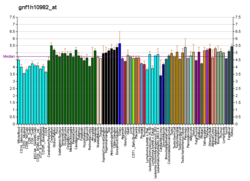La proteïna relacionada amb l'autofàgia 16-1 és una proteïna que en humans està codificada pel gen ATG16L1.[6]
L'autofàgia és el principal sistema de degradació intracel·lular, fent arribar components citoplasmàtics als lisosomes, i és la responsable de la degradació de la majoria de proteïnes de vida llarga i d'alguns orgànuls. Els components del citoplasma, incloent-hi els orgànuls, són segrestats en autofagosomes de doble membrana, que posteriorment es fusionen amb lisosomes. ATG16L1 és un component d'un gran complex proteic essencial per a l'autofàgia.[7][8]
- ↑ «Malalties que s'associen genèticament amb ATG16L1, vegeu/editeu les referències a wikidata».
- ↑ 2,0 2,1 2,2 ENSG00000085978 GRCh38: Ensembl release 89: ENSG00000281089, ENSG00000085978 - Ensembl, May 2017
- ↑ 3,0 3,1 3,2 GRCm38: Ensembl release 89: ENSMUSG00000026289 – Ensembl, May 2017
- ↑ «Human PubMed Reference:». National Center for Biotechnology Information, U.S. National Library of Medicine.
- ↑ «Mouse PubMed Reference:». National Center for Biotechnology Information, U.S. National Library of Medicine.
- ↑ Zheng H, Ji C, Li J, Jiang H, Ren M, Lu Q, Gu S, Mao Y, Xie Y «Cloning and analysis of human Apg16L». DNA sequence : the journal of DNA sequencing and mapping, 15, 4, Agost 2004, pàg. 303–5. DOI: 10.1080/10425170400004104. PMID: 15620219.
- ↑ Mizushima N, Kuma A, Kobayashi Y, Yamamoto A, Matsubae M, Takao T, Natsume T, Ohsumi Y, Yoshimori T «Mouse Apg16L, a novel WD-repeat protein, targets to the autophagic isolation membrane with the Apg12-Apg5 conjugate». Journal of Cell Science, 116, Pt 9, Maig 2003, pàg. 1679–88. DOI: 10.1242/jcs.00381. PMID: 12665549.
- ↑ «Entrez Gene: ATG16L1 ATG16 autophagy related 16-like 1 (S. cerevisiae)».
- ↑ Hampe J, Franke A, Rosenstiel P, Till A, Teuber M, Huse K, Albrecht M, Mayr G, De La Vega FM, Briggs J, Günther S, Prescott NJ, Onnie CM, Häsler R, Sipos B, Fölsch UR, Lengauer T, Platzer M, Mathew CG, Krawczak M, Schreiber S «A genome-wide association scan of nonsynonymous SNPs identifies a susceptibility variant for Crohn disease in ATG16L1». Nature Genetics, 39, 2, Febrer 2007, pàg. 207–11. DOI: 10.1038/ng1954. PMID: 17200669.
- ↑ Rioux JRioux JD, Xavier RJ, Taylor KD, Silverberg MS, Goyette P, Huett A, Green T, Kuballa P, Barmada MM, Datta LW, Shugart YY, Griffiths AM, Targan SR, Ippoliti AF, Bernard EJ, Mei L, Nicolae DL, Regueiro M, Schumm LP, Steinhart AH, Rotter JI, Duerr RH, Cho JH, Daly MJ, Brant SR' «Genome-wide association study identifies five novel susceptibility loci for Crohn's disease and implicates a role for autophagy in disease pathogenesis». Nature Genetics, 39, 5, Maig 2007, pàg. 596–604. DOI: 10.1038/ng2032. PMC: 2757939. PMID: 17435756.
- ↑ Burton, Paul R.; Clayton, David G.; Cardon, Lon R.; Craddock, Nick; Deloukas, Panos; Duncanson, Audrey; Kwiatkowski, Dominic P.; McCarthy, Mark I.; Ouwehand, Willem H. «Genome-wide association study of 14,000 cases of seven common diseases and 3,000 shared controls». Nature, 447, 7145, Juny 2007, pàg. 661–78. DOI: 10.1038/nature05911. PMC: 2719288. PMID: 17554300.
- Venter JC, Adams MD, Myers EW, et al. «The sequence of the human genome». Science, 291, 5507, 2001, pàg. 1304-51. DOI: 10.1126/science.1058040. PMID: 11181995.
- Strausberg RL, Feingold EA, Grouse LH, et al. «Generation and initial analysis of more than 15,000 full-length human and mouse cDNA sequences». Proc. Natl. Acad. Sci. U.S.A., 99, 26, 2003, pàg. 16899–903. DOI: 10.1073/pnas.242603899. PMC: 139241. PMID: 12477932.
- Mizushima N, Kuma A, Kobayashi Y, et al. «Mouse Apg16L, a novel WD-repeat protein, targets to the autophagic isolation membrane with the Apg12-Apg5 conjugate». J. Cell. Sci., 116, Pt 9, 2004, pàg. 1679–88. DOI: 10.1242/jcs.00381. PMID: 12665549.
- Clark HF, Gurney AL, Abaya E, et al. «The Secreted Protein Discovery Initiative (SPDI), a Large-Scale Effort to Identify Novel Human Secreted and Transmembrane Proteins: A Bioinformatics Assessment». Genome Res., 13, 10, 2003, pàg. 2265–70. DOI: 10.1101/gr.1293003. PMC: 403697. PMID: 12975309.
- Ota T, Suzuki Y, Nishikawa T, et al. «Complete sequencing and characterization of 21,243 full-length human cDNAs». Nat. Genet., 36, 1, 2004, pàg. 40-5. DOI: 10.1038/ng1285. PMID: 14702039.
- Bouwmeester T, Bauch A, Ruffner H, et al. «A physical and functional map of the human TNF-alpha/NF-kappa B signal transduction pathway». Nat. Cell Biol., 6, 2, 2004, pàg. 97–105. DOI: 10.1038/ncb1086. PMID: 14743216.
- Gerhard DS, Wagner L, Feingold EA, et al. «The Status, Quality, and Expansion of the NIH Full-Length cDNA Project: The Mammalian Gene Collection (MGC)». Genome Res., 14, 10B, 2004, pàg. 2121–7. DOI: 10.1101/gr.2596504. PMC: 528928. PMID: 15489334.
- Zheng H, Ji C, Li J, et al. «Cloning and analysis of human Apg16L». DNA Seq., 15, 4, 2005, pàg. 303–5. DOI: 10.1080/10425170400004104. PMID: 15620219.
- Kimura K, Wakamatsu A, Suzuki Y, et al. «Diversification of transcriptional modulation: Large-scale identification and characterization of putative alternative promoters of human genes». Genome Res., 16, 1, 2006, pàg. 55–65. DOI: 10.1101/gr.4039406. PMC: 1356129. PMID: 16344560.
- Hampe J, Franke A, Rosenstiel P, et al. «A genome-wide association scan of nonsynonymous SNPs identifies a susceptibility variant for Crohn disease in ATG16L1». Nat. Genet., 39, 2, 2007, pàg. 207–11. DOI: 10.1038/ng1954. PMID: 17200669.
- Ewing RM, Chu P, Elisma F, et al. «Large-scale mapping of human protein–protein interactions by mass spectrometry». Mol. Syst. Biol., 3, 1, 2007, pàg. 89. DOI: 10.1038/msb4100134. PMC: 1847948. PMID: 17353931.
- Prescott NJ, Fisher SA, Franke A, et al. «A nonsynonymous SNP in ATG16L1 predisposes to ileal Crohn's disease and is independent of CARD15 and IBD5». Gastroenterology, 132, 5, 2007, pàg. 1665–71. DOI: 10.1053/j.gastro.2007.03.034. PMID: 17484864.
- Yamazaki K, Onouchi Y, Takazoe M, et al. «Association analysis of genetic variants in IL23R, ATG16L1 and 5p13.1 loci with Crohn's disease in Japanese patients». J. Hum. Genet., 52, 7, 2007, pàg. 575–83. DOI: 10.1007/s10038-007-0156-z. PMID: 17534574.
- Baldassano RN, Bradfield JP, Monos DS, et al. «Association of the T300A non‐synonymous variant of the ATG16L1 gene with susceptibility to paediatric Crohn's disease». Gut, 56, 8, 2007, pàg. 1171–3. DOI: 10.1136/gut.2007.122747. PMC: 1955510. PMID: 17625155.






